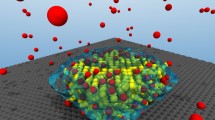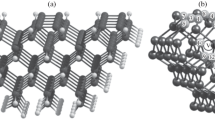Abstract
To elucidate the effects of physisorbed active ions on the geometries and electronic structures of hydrogenated diamond films, models of HCO -3 , H3O+, and OH− ions physisorbed on hydrogenated diamond (100) surfaces were constructed. Density functional theory was used to calculate the geometries, adsorption energies, and partial density of states. The results showed that the geometries of the hydrogenated diamond (100) surfaces all changed to different degrees after ion adsorption. Among them, the H3O+ ion affected the geometry of the hydrogenated diamond (100) surfaces the most. This is well consistent with the results of the calculated adsorption energies, which indicated that a strong electrostatic attraction occurs between the hydrogenated diamond (100) surface and H3O+ ions. In addition, electrons transfer significantly from the hydrogenated diamond (100) surface to the adsorbed H3O+ ion, which induces a downward shift in the HOMO and LUMO energy levels of the H3O+ ion. However, for active ions like OH− and HCO -3 , no dramatic change appears for the electronic structures of the adsorbed ions.
Similar content being viewed by others
References
M. I. Landstrass and K. V. Ravi, Hydrogen passivation of electrically active defects in diamond, Appl. Phys. Lett. 55, 1391 (1989)
B. Rezek, D. Shin, H. Watanabe, and C. E. Nebel, Intrinsic hydrogen-terminated diamond as ion-sensitive field effect transistor, Sensor Actuat. B-Chem. 122, 596 (2007)
C. Schreyvogel, M. Wolfer, H. Kato, M. Schreck, and C. E. Nebel, Tuned NV emission by in-plane Al-Schottky junctions on hydrogen terminated diamond, Sci. Rep. 4, 3634 (2014)
H. Kawarada, H. Sasaki, and A. Sato, Scanning-tunnelingmicroscope observation of the homoepitaxial diamond (001) 2×1 reconstruction observed under atmospheric pressure, Phys. Rev. B 52, 11351 (1995)
K. Hayashi, S. Yamanaka, and H. Watanabe, Investigation of the effect of hydrogen on electrical and optical properties in chemical vapor deposited on homoepitaxial diamond films, J. Appl. Phys. 81, 744 (1997)
F. B. Liu, J. D. Wang, D. R. Chen, M. Zhao, and G. P. He, The microstructures of the diamond (100) surfaces with different density of hydrogen adsorption, Acta Phys. Sin. 59, 6556 (2010) (in Chinese)
E. B. Lombardi, A. Mainwood, and K. Osuch, Interaction of hydrogen with boron, phosphorus, and sulfur in diamond, Phys. Rev. B 70, 205201 (2004)
K. Bobrov, A. J. Mayne, A. Hoffman, and G. Dujardin, Atomic-scale desorption of hydrogen from hydrogenated diamond surfaces using the STM, Surf. Sci. 528, 138 (2003)
F. Maier, M. Riedel, B. Mantel, J. Ristein, and L. Ley, Origin of surface conductivity in diamond, Phys. Rev. Lett. 85, 3472 (2000)
J. P. Goss, B. Hourahine, R. Jones, M. I. Heggie, and P. R. Briddon, p-type surface doping of diamond: a first-principles study, J. Phys.: Condens. Matter 13, 8973 (2001)
M. M. Hassan and K. Larsson, Effect of surface termination on diamond (100) surface electrochemistry, J. Phys. Chem. C 118, 22995 (2014)
V. Chakrapani, J. C. Angus, A. B. Anderson, S. D. Wolter, B. R. Stoner, and G. U. Sumanasekera, Charge transfer equilibria between diamond and an aqueous oxygen electrochemical redox couple, Science 318, 1424 (2007)
Q. X. Zhou, C. Y. Wang, Z. B. Fu, Y. J. Tang, and H. Zhang, Effects of various defects on the electronic properties of single-walled carbon nanotubes: A first principle study, Front. Phys. 9, 200 (2014)
Z. J. Ding, Y. Jiao, and S. Meng, Quantum simulation of molecular interaction and dynamics at surfaces, Front. Phys. 6, 294 (2011)
J. Furthmüller, J. Hafner, and G. Kresse, Dimer reconstruction and electronic surface states on clean and hydrogenated diamond (100) surfaces, Phys. Rev. B 53, 7334 (1996)
K. Bobrov, A. Mayne, G. Comtet, G. Dujardin, L. Hellner, and A. Hoffman, Atomic-scale visualization and surface electronic structure of the hydrogenated diamond C (100)- (2×1): H surface, Phys. Rev. B 68, 195416 (2003)
M. J. Rutter and J. Robertson, Ab initio calculation of electron affinities of diamond surfaces, Phys. Rev. B 57, 9241 (1998)
F. Maier, J. Risten, and L. Ley, Electron affinity of plasmahydrogenated and chemically oxidized diamond (100) surfaces, Phys. Rev. B 64, 165411 (2001)
Y. Takagi, K. Shiraishi, M. Kasu, and H. Sato, Mechanism of hole doping into hydrogen terminated diamond by the adsorption of inorganic molecule, Surf. Sci. 609, 203 (2013)
H. Sato and M. Kasu, Electronic properties of H-terminated diamond during NO2 and O3 adsorption and desorption, Diamond Relat. Mater. 24, 99 (2012)
K. G. Girija, J. Nuwad, and R. K. Vatsa, Hydrogenated diamond as room temperature H2S sensor, Diamond Relat. Mater. 40, 38 (2013)
S. Beer, A. Helwig, G. Müller, J. Garrido, and M. Stutzmann, Water adsorbate mediated accumulation gas sensing at hydrogenated diamond surfaces, Sens. Actuat. B 181, 894 (2013)
A. Helwig, G. Müller, J. A. Garrido, and M. Eickhoff, Gas sensing properties of hydrogen-terminated diamond, Sens. Actuat. B 133, 156 (2008)
M. Kubovic, M. Kasu, and H. Kageshima, Electronic and surface properties of H-terminated diamond surface affected by NO2 gas, Appl. Phys. Lett. 96, 052101 (2010)
Author information
Authors and Affiliations
Corresponding author
Rights and permissions
About this article
Cite this article
Liu, FB., Li, JL., Chen, WB. et al. Geometries and electronic structures of the hydrogenated diamond (100) surface upon exposure to active ions: A first principles study. Front. Phys. 11, 116804 (2016). https://doi.org/10.1007/s11467-015-0516-7
Received:
Accepted:
Published:
DOI: https://doi.org/10.1007/s11467-015-0516-7




